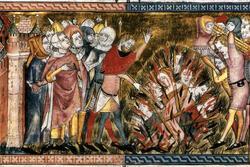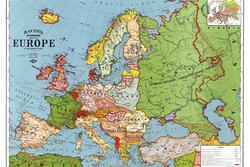Caroline Calloway and Antisemitic Caricature
The queen of controversial content, Caroline Calloway was recently dubbed “the world’s most infamous influencer,” a title earned after her failed series of so-called “creativity workshops” and ongoing saga with former friend and ghostwriter Natalie Beach went viral in 2019. After the publication of Beach’s exposé about her volatile relationship with Calloway in The Cut, the 28-year-old Virginia native was branded a “scammer.” Yet the drama only helped Calloway, who is often described as a woman everyone loves to hate, achieve her desire for fame above all else. Since then, Calloway has honed a loyal and ever-increasing fan base—whom she claims are obsessed with the most mundane details of her life—through her prolific social media posting, polarizing opinions, and self-made art.
You might be wondering what an online influencer familiar only to those who are “extremely online” has to do with… anything, which brings me to one of her (many) recent tweets.
In late April, Calloway tweeted an image of a cartoon man with a hooked nose surrounded by bags of money being carried on the backs of two dishevelled workers. She captioned it “#ThingsRichPeopleBuy Natalie’s talent,” a subtle dig at Beach. Almost immediately, people commented on the illustration’s antisemitic overtones, leading Calloway to apologize.
My privilege kept me from seeing the antisemetic undertones in this cartoon and I take full responsibility for that. I’m always learning and unlearning, but I really fucked up when I reposted this just because of a turquoise background. I sincerely apologize if I caused you harm. pic.twitter.com/xyZni16efO
— ◥◤Caroline Calloway (@carolinecaloway) April 28, 2020
It is not unusual for Calloway’s content to attract critical engagement from fans and keyboard warriors alike, and this was no different. The apology sparked a host of responses about whether the obviously caricatured “Jewish” image really was offensive. These ranged from reductive claims that some viewers harbor a “willingness” to see discrimination where there is none, to arguments pointing out that Calloway’s ignorance is perhaps rooted in the very normalization of such images within popular culture.
One such tweet read: “There may be a lesson here in how often caricatured Jewish stereotypes are used to represent evil characters.” Demonstrating how often these tropes go unnoticed, another tweet empathized with Calloway’s mistake: “To be honest, I didn’t catch that either...I saw it when you posted it, I thought it looked like the Despicable Me guy, but never gave it another thought and kept scrolling.”
Calloway’s tweet aside, in a global context, pop culture examples of Jewish caricature are common and cut across different types of media and genres. At the end of last year, for example, J.K. Rowling came under fire on Twitter for her representation of Gringotts goblins as greedy hook-nosed bankers in the Harry Potter films, while a recent Washington Post article points out the prevalence of aliens with similar characteristics in the popular sci-fi franchises Star Trek and Star Wars. Even the much-loved American sitcom Parks and Recreation is guilty of insensitive Jewish representation, evident in the Saperstein family (the only Jewish characters in the entire show), made up of money-obsessed siblings Jean-Ralphio and Mona-Lisa and their rich, scamming father Dr. Saperstein.
It's not just transphobia. Can we also talk about JK Rowling's anti-Semitic goblins?
— Max Curtis (@MaxCCurtis) December 19, 2019
In Harry Potter the greedy, hook-nosed monsters are bankers. In Fantastic Beasts, they have Jewish actor Ron Perlman play a 1920s Jewish gangster... related to bankers. pic.twitter.com/kZHMcRdDyH
These pervasive stereotypes are rooted in a history of Jewish caricature that dates to the medieval era, when Jews arrived in Europe for work and business opportunities and excelled as craftsmen, skilled laborers, and moneylenders. Oversimplified caricatures from the thirteenth century focused on the commercial success of Jewish people and demonized them as money-grabbing, terrifying outsiders who, according to Christian society, were responsible for the crucifixion of Christ. Jewish people were said to have a connection with the devil and were othered for their “strange” customs, language, close-knit communities, dress codes, and kosher diets.
The stereotype of the “greedy Jew” evolved through the centuries and contributed to the idea that the Jewish diaspora was parasitic, that Jews wandered from place to place and fed off the nations of others. Jews gained a particular association with vampires, the blood-sucking gothic monsters, due to accusations of blood libel (the claim that Jews murdered gentiles, especially children, for the ritual use of their blood).
The Third Reich used many of these antisemitic tropes to scapegoat European Jews for Germany’s economic insecurities in the 1930s and to justify the Holocaust, as well as to develop a eugenics system based on pseudo-scientific evidence of Jews’ sub-human status. The “Jewish nose” is one of the defining physical stereotypes that has persisted in contemporary caricature, along with protruding ears and beady eyes—features that were grotesquely depicted in Nazi propaganda to vilify Jewish people.
Calloway, who is no stranger to being portrayed as a villain herself, explained that she thought the (now-deleted) image was just “a cartoon vilifying the rich.” “My privilege kept me from seeing the antisemitic undertones in this cartoon,” she commented, and later clarified that the image was “an offensive, abhorrent” thing to have shared. This latest chapter of Calloway’s online epic shows how ingrained anti-Jewish caricatures are within popular culture. It also shows how quickly those with large online platforms have the potential to widely disseminate this material.
Whether intentional or otherwise, sharing images that draw on caricatured antisemitic features unconsciously reinforces negative stereotypes that are damaging and offensive. Perhaps this was a deliberate ploy by Calloway, whose name has been searched over 2,250,000 times on Google (and who at one time had more hits than the British Prime Minister, Boris Johnson), to generate discussion and publicize her own brand—after all, she has shown that she doesn’t mind throwing herself under the bus of “cancel culture” for clicks, and revels in her “scammer” title.
Maybe the mistake was an honest one, and the apology genuine. Regardless, mistakes or purposeful errors like Calloway’s are at least opportunities to open up important conversations about representation and appropriation. My editor remarks that she never expected to publish Caroline Calloway content at JWA, but here we are!








Just who is the « Baldinger » person who created this cartoon in the first place?
Let’s not be too easily of Ms. Calloway—I recall a conversation with her during our university years in which she admitted changing her name from Gottschal to Calloway as the prior “sounded too Jewish”.
Hi, thanks for this - it was super interesting! I just wanted to flag (and I don’t know if this was a deliberate error or just a sentence structure sort of thing) but Jews were in Europe well before the 13th century and before the medieval period!
I think this is a great article, especially the points made about anti-semitism in popular media like parks and rec and harry potter that often goes unexamined. I do think this story failed to mention that Calloway “liked” and shared (on instagram) a joke about dressing up as Anne Frank on OnlyFans within 24 hours of tweeting the picture the article mentions. She deleted it after being called out, but did not apologize or address why she thought it was necessary or funny to sexualize Anne Frank. I think that’s relevant information when it comes to a discussion of her apology.